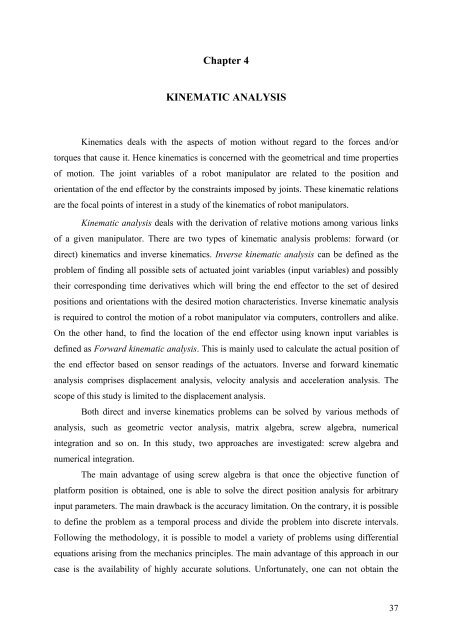Kinematic and Dynamic Analysis of Spatial Six Degree of Freedom ...
Kinematic and Dynamic Analysis of Spatial Six Degree of Freedom ...
Kinematic and Dynamic Analysis of Spatial Six Degree of Freedom ...
Create successful ePaper yourself
Turn your PDF publications into a flip-book with our unique Google optimized e-Paper software.
Chapter 4<br />
KINEMATIC ANALYSIS<br />
<strong>Kinematic</strong>s deals with the aspects <strong>of</strong> motion without regard to the forces <strong>and</strong>/or<br />
torques that cause it. Hence kinematics is concerned with the geometrical <strong>and</strong> time properties<br />
<strong>of</strong> motion. The joint variables <strong>of</strong> a robot manipulator are related to the position <strong>and</strong><br />
orientation <strong>of</strong> the end effector by the constraints imposed by joints. These kinematic relations<br />
are the focal points <strong>of</strong> interest in a study <strong>of</strong> the kinematics <strong>of</strong> robot manipulators.<br />
<strong>Kinematic</strong> analysis deals with the derivation <strong>of</strong> relative motions among various links<br />
<strong>of</strong> a given manipulator. There are two types <strong>of</strong> kinematic analysis problems: forward (or<br />
direct) kinematics <strong>and</strong> inverse kinematics. Inverse kinematic analysis can be defined as the<br />
problem <strong>of</strong> finding all possible sets <strong>of</strong> actuated joint variables (input variables) <strong>and</strong> possibly<br />
their corresponding time derivatives which will bring the end effector to the set <strong>of</strong> desired<br />
positions <strong>and</strong> orientations with the desired motion characteristics. Inverse kinematic analysis<br />
is required to control the motion <strong>of</strong> a robot manipulator via computers, controllers <strong>and</strong> alike.<br />
On the other h<strong>and</strong>, to find the location <strong>of</strong> the end effector using known input variables is<br />
defined as Forward kinematic analysis. This is mainly used to calculate the actual position <strong>of</strong><br />
the end effector based on sensor readings <strong>of</strong> the actuators. Inverse <strong>and</strong> forward kinematic<br />
analysis comprises displacement analysis, velocity analysis <strong>and</strong> acceleration analysis. The<br />
scope <strong>of</strong> this study is limited to the displacement analysis.<br />
Both direct <strong>and</strong> inverse kinematics problems can be solved by various methods <strong>of</strong><br />
analysis, such as geometric vector analysis, matrix algebra, screw algebra, numerical<br />
integration <strong>and</strong> so on. In this study, two approaches are investigated: screw algebra <strong>and</strong><br />
numerical integration.<br />
The main advantage <strong>of</strong> using screw algebra is that once the objective function <strong>of</strong><br />
platform position is obtained, one is able to solve the direct position analysis for arbitrary<br />
input parameters. The main drawback is the accuracy limitation. On the contrary, it is possible<br />
to define the problem as a temporal process <strong>and</strong> divide the problem into discrete intervals.<br />
Following the methodology, it is possible to model a variety <strong>of</strong> problems using differential<br />
equations arising from the mechanics principles. The main advantage <strong>of</strong> this approach in our<br />
case is the availability <strong>of</strong> highly accurate solutions. Unfortunately, one can not obtain the<br />
37
















